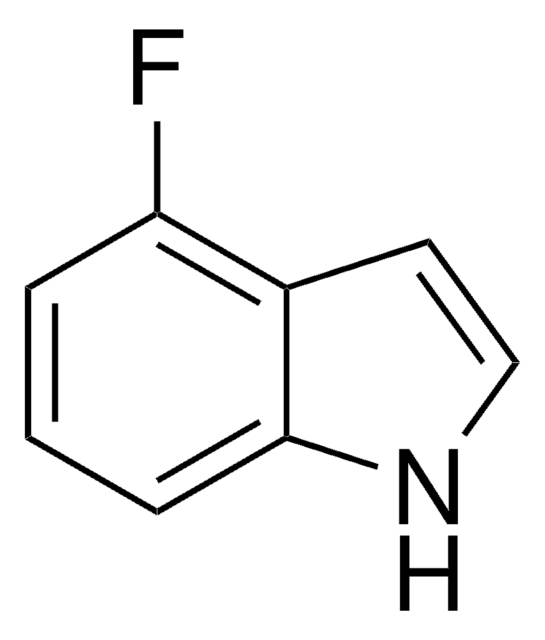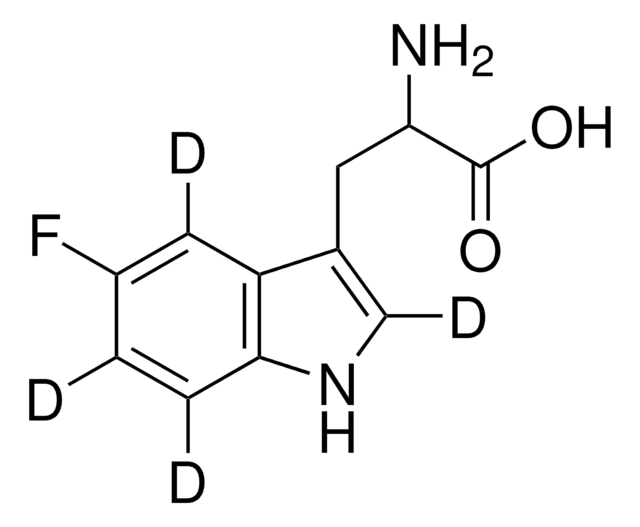All Photos(1)
About This Item
Empirical Formula (Hill Notation):
C11H11FN2O2
CAS Number:
Molecular Weight:
222.22
MDL number:
UNSPSC Code:
12352200
PubChem Substance ID:
NACRES:
NA.26
Recommended Products
Assay
≥98.0% (TLC)
form
crystalline
technique(s)
NMR: suitable
color
off-white
storage temp.
−20°C
SMILES string
NC(Cc1c[nH]c2cccc(F)c12)C(O)=O
InChI
1S/C11H11FN2O2/c12-7-2-1-3-9-10(7)6(5-14-9)4-8(13)11(15)16/h1-3,5,8,14H,4,13H2,(H,15,16)
InChI key
DEBQMEYEKKWIKC-UHFFFAOYSA-N
Biochem/physiol Actions
4-Fluoro-DL-tryptophan (4-F-TRP) is used to label bacterial arginyl-tRNA synthetases for conformational analysis and to label myoglobins and hemoglobins for NMR spectra analysis.
Storage Class Code
13 - Non Combustible Solids
WGK
WGK 3
Flash Point(F)
Not applicable
Flash Point(C)
Not applicable
Certificates of Analysis (COA)
Search for Certificates of Analysis (COA) by entering the products Lot/Batch Number. Lot and Batch Numbers can be found on a product’s label following the words ‘Lot’ or ‘Batch’.
Already Own This Product?
Find documentation for the products that you have recently purchased in the Document Library.
P Soumillion et al.
Biochemistry, 37(7), 1819-1827 (1998-03-04)
Clamp proteins confer processivity to the DNA polymerase during DNA replication. These oligomeric proteins are loaded onto DNA by clamp loader protein complexes in an ATP-dependent manner. The mechanism by which the trimeric bacteriophage T4 clamp protein (the 45 protein)
Q S Zhang et al.
Journal of protein chemistry, 18(2), 187-192 (1999-05-20)
Escherichia coli 4-fluorotryptophan-substituted arginyl-tRNA synthetase was biosynthetically prepared and purified from a tryptophan auxotroph which could overproduce this enzyme. A method was developed to separate 4-fluorotryptophan from tryptophan and to determine accurately their contents in the 4-fluorotryptophan-containing proteins. It was
P M Bronskill et al.
The Biochemical journal, 249(1), 305-308 (1988-01-01)
The tryptophan-auxotrophic Bacillus subtilis LC33 mutant strain utilizes either tryptophan or 4-fluorotryptophan for growth. Proteins therefore could be isolated from these cells in either tryptophan-containing or 4-fluorotryptophan-containing forms. Since 4-fluorotryptophan is non-fluorescent, tryptophan fluorescence would be suppressed in the 4-fluorotryptophan-containing
J L Hott et al.
The Biochemical journal, 264(1), 297-299 (1989-11-15)
The derivative 4-fluorotryptophan was confirmed to have negligible fluorescence at 25 degrees C and 285 nm (tryptophan/4-fluorotryptophan quantum-yield ratio greater than 100:1). However, photolysis experiments on tryptophan and 4-fluorotryptophan, in which loss of starting material was measured by reverse-phase h.p.l.c.
J G Pearson et al.
Biochemistry, 36(12), 3590-3599 (1997-03-25)
We have obtained the 470 MHz 19F NMR spectra of wild type [4-F]Trp-labeled myoglobins (MbCO, MbO2, deoxyMb, metMb, and MbCN) and hemoglobins (HbCO, HbO2, and deoxyHb), as well as those of several mutants (W7F Mb, betaW15F Hb, betaW37S Hb, and
Our team of scientists has experience in all areas of research including Life Science, Material Science, Chemical Synthesis, Chromatography, Analytical and many others.
Contact Technical Service







